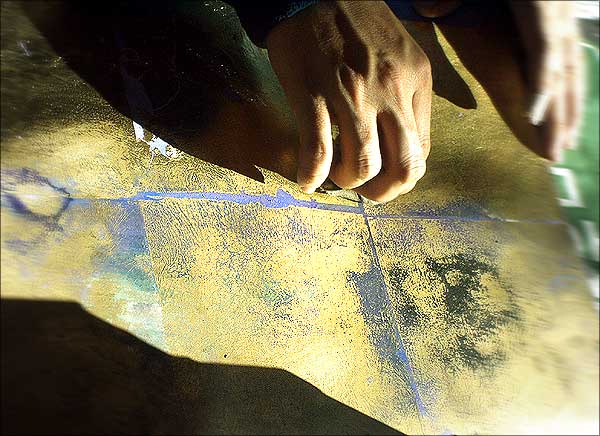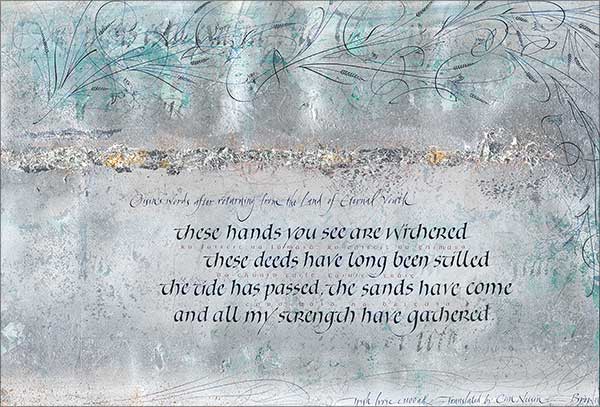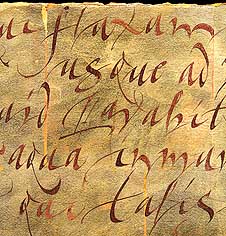
Experimental Gilding with Copper & Brass
2 or 3 day Workshop for calligraphers with Denis Brown
Level: All, from beginners to advanced
Illustrated above: A student abrades metal leaf with pumice powder to reveal colors underneath. Heng Chiew Chiam, in Melbourne, Australia, 2005
An exploration of the nature and uses for the calligrapher of copper and brass leaf, (schlag or dutch metal), and of bronze powders. This is not a class about imitating real gold, rather we will capitalize on unique properties of cupric metal for stunning effects.
Using various binders, we will make our own gold inks, superior to and more adaptable than those available commercially. A beautiful (yet easy!) technique will be explored, where broken leaf-gilt surfaces partially reveal color washes underneath the metal, and the whole surface will be prepared as a background for fine calligraphy.
Patination of the gilded surface, to oxidize the metal into unexpected new colors, will also be demonstrated. Participants will be advised on layout as they prepare designs incorporating the various gilding techniques learned.
 |
Calligraphy by Denis Brown on textured aluminum leaf as demonstrated in the workshop
Click image for enlarged detail
Tools and Materials:
Bronze powder, in both a gold/brass color and a pure copper.
A vial or small jar of each metal powder will be enough.
Aluminum powder: A vial or small jar.
Metal Composition Leaf, (alternatively called Dutch metal,Schlag leaf, or Imitation gold): one book (25 leaves, c. 5"x5") of a natural gold color; one book of pure copper leaf, and one book of pure aluminum. All leaf should be patent, i.e., attached to a transfer tissue.
Powdered pumice, c. 4oz container.
Gum sandarac: c. 1oz container. (You can buy it unground and grind it in a mortar & pestle, which is what I do, OR buy it already ground but in many such cases I recommend grinding it finer anyway).
Roll of gummed paper tape at least 1.5" or 4cm wide. (This is the kind of tape used for stretching watercolor paper after wetting it with a sponge).
Small sponge for wetting the above gum-strip tape.
A rigid board for stretching paper, e.g. quarter inch plywood or MDF
size at least 15" x 20"
Liquid acrylic paints in a range of colors, (or any WATERPROOF paint suitable for making a color wash. (E.g., 'plaka' or tubes of acrylic also may be used)
Gum arabic: A small bottle of c. 2.5 fl. oz. prepared liquid gum arabic, as distinct from undissolved gum.
PVA glue, c. 8oz bottle.
A large flat nylon paintbrush, c. 1" wide.
11"x l7 " pad of thick smooth white paper c.250gsm or a dozen individual sheets about this size.
2 full size sheets of a hot-pressed watercolor paper, c.250gsm or heavier. (I like Saunders Waterford and BFK Rives, but different countries may offer different brands equally suitable).
An eyedropper or pipette, made of glass not plastic.
Old newspapers & clean rags.
A plastic teaspoon or two.
Scalpel or sharp scissors.
6 or more small containers with airtight lids (35mm photo film canisters were ideal before we all went digital!)
Calligraphy dip-pens, pencils, ruler, gouache paints, mixing brushes, palettes.
Optional: Mortar & pestle, needed only if your sandarac is unground. Large ceramic or stone, c 5" diameter (easier to use than smaller ones).
Optional: Artists oil-painting varnish, (matt or gloss) plus turpentine or white spirit for cleaning.(A varnish will fully protect gilt papers from tarnishing over time, but is optional since I prefer the unvarnished surface and find tarnishing is minimal anyway)
